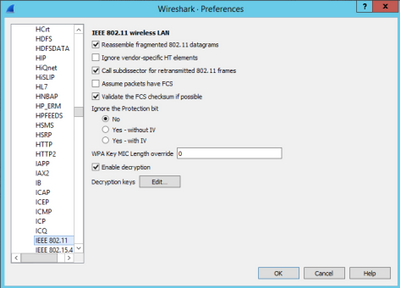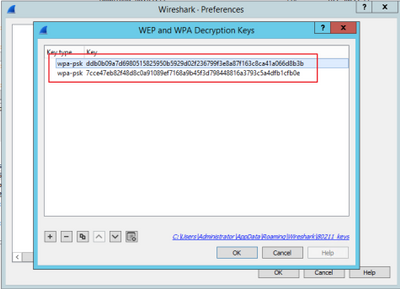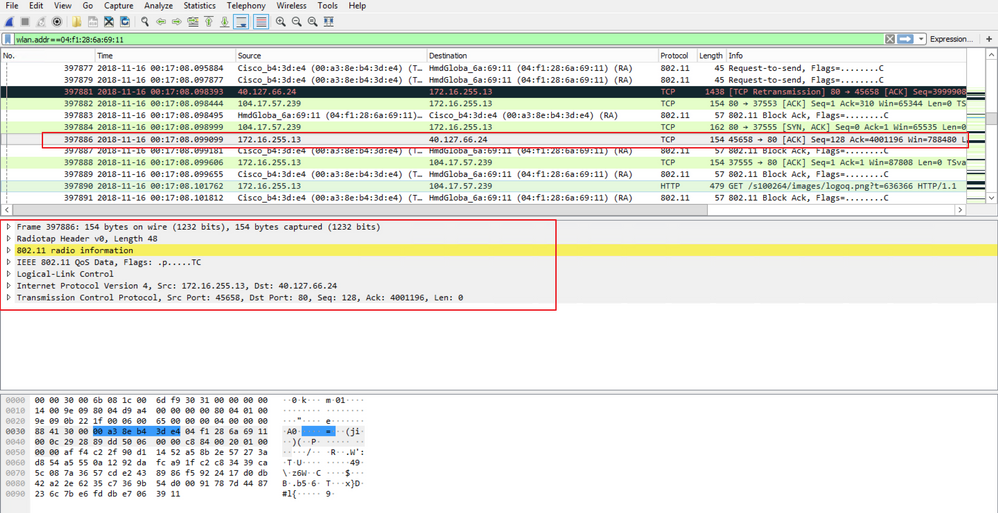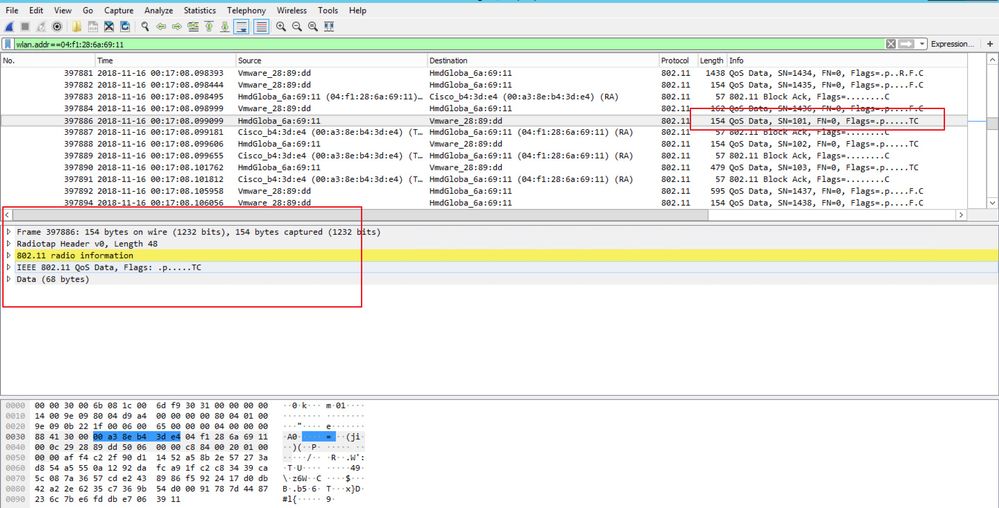Introduction
This document describes a how-to of decrypting Wi-Fi Protected Access 2 - Enterprise (WPA2-Enterprise) or 802.1x (dot1x) encrypted wireless over-the-air (OTA) sniffer, with any Extensible Authentication Protocol (EAP) methods.
It is relatively easy to decrypt PSK based/WPA2-personal 802.11 OTA capture as long as the full four-way EAP over LAN (EAPoL) handshakes are captured. However, Pre-shared Key (PSK) is not always recommended from a security perspective. Cracking a hard-coded password is just a matter of time.
Hence, many enterprises choose dot1x with Remote Authentication Dial-In User Service (RADIUS) as a better security solution for their wireless network.
Prerequisites
Requirements
Cisco recommends that you have knowledge of these topics:
- FreeRADIUS with radsniff installed
- Wireshark/Omnipeek or any software that is capable of decrypting 802.11 wireless traffic
- Privilege to obtain the shared secret between network access server (NAS) and Authenticator
- Ability to capture radius packet capture between NAS and authenticator from the first access-request (from NAS to Authenticator) to the last access-accept (from Authenticator to NAS) throughout the EAP session
- Ability to perform Over-the-Air (OTA) capture containing four-way EAPoL handshakes
Components Used
The information in this document is based on these software and hardware versions:
- Radius server (FreeRADIUS or ISE)
- Over-the-Air capture device
- Apple macOS/OS X or Linux device
The information in this document was created from the devices in a specific lab environment. All of the devices used in this document started with a cleared (default) configuration. If your network is live, ensure that you understand the potential impact of any command.
Background Information
In this example, two Pairwise Master Keys (PMKs) are derived from Radius packets captured from ISE 2.3, as the session timeout on this SSID is 1800 secs, and the capture given here is 34 mins (2040 secs) long.
As shown in the image, EAP-PEAP is used as an example, but this can be applied to any dot1x based wireless authentication.


Procedure
Step 1. Decrypt PMK(s) from Access-accept Packet.
Run the radsniff against radius capture between NAS and Authenticator in order to extract PMK. The reason why two access-accept packets are extracted during the capture is that the session timeout timer is set to 30 mins on this particular SSID and the capture is 34 mins long. Authentication is performed twice.
FRLU-M-51X5:pcaps frlu$ radsniff -I /Users/frlu/Downloads/radius_novlan_merged.pcapng -s <shared-secret between NAS and Authenticator> -x
<snip>
2018-11-16 11:39:01.230000 (24) Access-Accept Id 172 /Users/frlu/Downloads/radius_novlan_merged.pcapng:10.66.79.42:32771 <- 10.66.79.36:1812 +0.000 +0.000
User-Name = "frlu_2"
State = 0x52656175746853657373696f6e3a306134323466326130303030303565373562656530393732
Class = 0x434143533a3061343234663261303030303035653735626565303937323a4953452d322d332f3332383237313233382f33303432
EAP-Message = 0x03c50004
Message-Authenticator = 0x38c67b9ba349842c9624889a45cabdfb
MS-MPPE-Send-Key = 0xa464cc15c0df8f09edc249c28711eb13a6db2d1a176f1196edcc707579fd6793
MS-MPPE-Recv-Key = 0xddb0b09a7d6980515825950b5929d02f236799f3e8a87f163c8ca41a066d8b3b<<<<<<<<<<<<<<<<<<PMK
Authenticator-Field = 0x6cd33b4d4dde05c07d9923e17ad6c218
<snip>
2018-11-16 11:39:01.470000 (48) Access-Accept Id 183 /Users/frlu/Downloads/radius_novlan_merged.pcapng:10.66.79.42:32771 <- 10.66.79.36:1812 +0.000 +0.000
User-Name = "frlu_2"
State = 0x52656175746853657373696f6e3a306134323466326130303030303565373562656530393732
Class = 0x434143533a3061343234663261303030303035653735626565303937323a4953452d322d332f3332383237313233382f33303434
EAP-Message = 0x03910004
Message-Authenticator = 0x81c572651679e15e54a900f3360c0aa9
MS-MPPE-Send-Key = 0xeae42cf7c6cd26371eee29856c51824fbb5bbb298874125928470114d009b5fb
MS-MPPE-Recv-Key = 0x7cce47eb82f48d8c0a91089ef7168a9b45f3d798448816a3793c5a4dfb1cfb0e<<<<<<<<<<<<<<<<<PMK
Authenticator-Field = 0xa523dd9ec2ce93d19fe4fc2e21537a5d
Note: Please remove any virtual LAN (VLAN) tag of the Radius packet capture, otherwise, radsniff does not recognise the input pcap file. In order to remove any VLAN tag, for example, editcap can be used.
Tip: Generally, the runtime of radsniff command against a RADIUS pcap file can be counted as a scale of seconds. However, if the radsniff is stuck in this state shown in the log, please cascade this packet capture (A) with another longer packet capture (B) between the same NAS and Authenticator. Then, run the radsniff command against the cascaded packet (A+B). The only requirement of packet capture (B) is that you are able to run the radsniff command against it and see verbose result.
FRLU-M-51X5:pcaps frlu$ radsniff -I /Users/frlu/Downloads/radius_novlan.pcap -s Cisco123 -x
Logging all events
Sniffing on (/Users/frlu/Downloads/radius_novlan.pcap)
In this example, the Wireless Lan Controller (WLC) control plane logging (A) that is captured via WLC packet logging feature, is cascaded with a longer capture from ISE's TCPdump (B). WLC packet logging is used as an example because it is usually very small in size.
WLC packet logging (A)

ISE Tcpdump (B)

Merged (A+B)

Then run the radsniff against the merged pcap (A+B) and you will be able to see the verbose output.
FRLU-M-51X5:pcaps frlu$ radsniff -I /Users/frlu/Downloads/radius_novlan_merged.pcapng -s <shared-secret between NAS and Authenticator> -x
<snip>
2018-11-16 11:39:01.230000 (24) Access-Accept Id 172 /Users/frlu/Downloads/radius_novlan_merged.pcapng:10.66.79.42:32771 <- 10.66.79.36:1812 +0.000 +0.000
<snip>
Step 2. Extract PMK(s).
Delete of 0x field in each MS-MPPE-Recv-Key from the verbose output and the PMKs that is needed for the wireless traffic decode is then presented.
MS-MPPE-Recv-Key = 0xddb0b09a7d6980515825950b5929d02f236799f3e8a87f163c8ca41a066d8b3b
PMK:
ddb0b09a7d6980515825950b5929d02f236799f3e8a87f163c8ca41a066d8b3b
MS-MPPE-Recv-Key = 0x7cce47eb82f48d8c0a91089ef7168a9b45f3d798448816a3793c5a4dfb1cfb0e
PMK:
7cce47eb82f48d8c0a91089ef7168a9b45f3d798448816a3793c5a4dfb1cfb0e
Step 3. Decrypt the OTA Sniffer.
Navigate to Wireshark > Preferences > Protocols > IEEE 802.11. Then tick on Enable Decryption and click on the Edit button next to Decryption Keys, as shown in the image.

Next, please select wpa-psk as the Key type, and put the PMKs derived in the Key field, and then click on OK. After this is completed, the OTA capture should be decrypted and you are able to see higher layer (3+) information.

Example of a Decrypted 802.11 Packet

If you compare the second result where the PMK is not included, with the first result, where the PMK is included, packet 397886 is decrypted as 802.11 QoS data.
Example of an Encrypted 802.11 Packet

Caution: You may encounter issue with Wireshark on decryption, and in that case, even if the right PMK is provided, (or if PSK is used, both SSID and PSK are provided), Wireshark does not decrypt the OTA capture. The workaround is to turn Wireshark off and on a few times until higher layer information can be obtained and 802.11 packets are no longer shown as QoS data, or to use another PC/Mac where Wireshark is installed.
Tip: A C++ code called pmkXtract is attached in the first post in Related Information. Attempts to compiled were successfully and an executable file is obtained, but the executable program does not seem to perform the decryption properly for some uknown reasons. In addition, a Python script that attempts to extract PMK is posted in the comment area on the first post, which can be further explored if readers are interested.
Related Information










 Feedback
Feedback